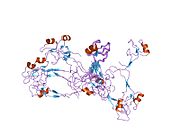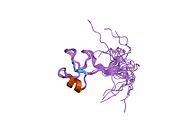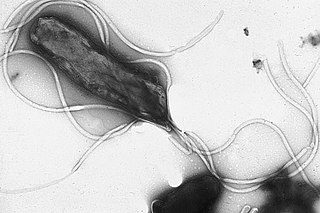
Helicobacter pylori, previously known as Campylobacter pylori, is a gram-negative, flagellated, helical bacterium. Mutants can have a rod or curved rod shape, and these are less effective. Its helical body is thought to have evolved in order to penetrate the mucous lining of the stomach, helped by its flagella, and thereby establish infection. The bacterium was first identified as the causal agent of gastric ulcers in 1983 by the Australian doctors Barry Marshall and Robin Warren.

Estrogen receptors (ERs) are a group of proteins found inside cells. They are receptors that are activated by the hormone estrogen (17β-estradiol). Two classes of ER exist: nuclear estrogen receptors, which are members of the nuclear receptor family of intracellular receptors, and membrane estrogen receptors (mERs), which are mostly G protein-coupled receptors. This article refers to the former (ER).

Estrogen receptor alpha (ERα), also known as NR3A1, is one of two main types of estrogen receptor, a nuclear receptor that is activated by the sex hormone estrogen. In humans, ERα is encoded by the gene ESR1.

The trefoil knot fold is a protein fold in which the protein backbone is twisted into a trefoil knot shape. "Shallow" knots in which the tail of the polypeptide chain only passes through a loop by a few residues are uncommon, but "deep" knots in which many residues are passed through the loop are extremely rare. Deep trefoil knots have been found in the SPOUT superfamily. including methyltransferase proteins involved in posttranscriptional RNA modification in all three domains of life, including bacterium Thermus thermophilus and proteins, in archaea and in eukaryota.

Transforming growth factor alpha (TGF-α) is a protein that in humans is encoded by the TGFA gene. As a member of the epidermal growth factor (EGF) family, TGF-α is a mitogenic polypeptide. The protein becomes activated when binding to receptors capable of protein kinase activity for cellular signaling.
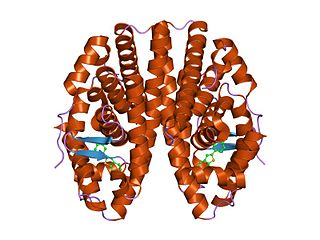
The nuclear receptor coactivator 2 also known as NCoA-2 is a protein that in humans is encoded by the NCOA2 gene. NCoA-2 is also frequently called glucocorticoid receptor-interacting protein 1 (GRIP1), steroid receptor coactivator-2 (SRC-2), or transcriptional mediators/intermediary factor 2 (TIF2).

AKT2, also known as RAC-beta serine/threonine-protein kinase, is an enzyme that in humans is encoded by the AKT2 gene. It influences metabolite storage as part of the insulin signal transduction pathway.
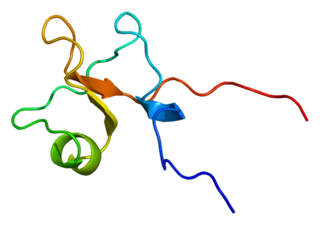
Trefoil factor 3 is a protein that in humans is encoded by the TFF3 gene.

Forkhead box protein O4 is a protein that in humans is encoded by the FOXO4 gene.

Trefoil factor 2 is a protein that in humans is encoded by the TFF2 gene.

Scaffold attachment factor B, also known as SAFB, is a gene with homologs that have been studied in humans and mice.

Metastasis-associated protein MTA2 is a protein that in humans is encoded by the MTA2 gene.

Anterior gradient protein 2 homolog (AGR-2), also known as secreted cement gland protein XAG-2 homolog, is a protein that in humans is encoded by the AGR2 gene. Anterior gradient homolog 2 was originally discovered in Xenopus laevis. In Xenopus AGR2 plays a role in cement gland differentiation, but in human cancer cell lines high levels of AGR2 correlate with downregulation of the p53 response, cell migration, and cell transformation. However, there have been other observations that AGR2 can repress growth and proliferation.

Breast cancer anti-estrogen resistance protein 3 is a protein that in humans is encoded by the BCAR3 gene.

Pepsinogen A is a protein that in humans is encoded by the PGA5 gene.

NAD-dependent deacetylase sirtuin-3, mitochondrial also known as SIRT3 is a protein that in humans is encoded by the SIRT3 gene [sirtuin 3 ]. SIRT3 is member of the mammalian sirtuin family of proteins, which are homologs to the yeast Sir2 protein. SIRT3 exhibits NAD+-dependent deacetylase activity.

Zinc transporter ZIP6 is a protein that in humans is encoded by the SLC39A6 gene.

Gastrokine-1 is a protein that in humans is encoded by the GKN1 gene.

MCF-7 is a breast cancer cell line isolated in 1970 from a 69-year-old White woman. MCF-7 is the acronym of Michigan Cancer Foundation-7, referring to the institute in Detroit where the cell line was established in 1973 by Herbert Soule and co-workers. The Michigan Cancer Foundation is now known as the Barbara Ann Karmanos Cancer Institute.

Signal peptide, CUB domain and EGF like domain containing 1 is a protein that in humans is encoded by the SCUBE1 gene.


























